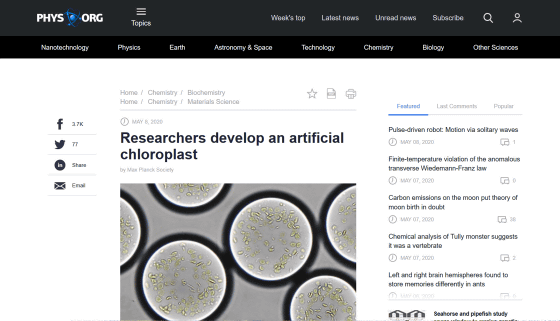Researchers develop 'artificial chloroplasts' that convert carbon dioxide into organic compounds in the sunlight at a faster speed than before

Light-powered CO2 fixation in a chloroplast mimic with natural and synthetic parts | Science
https://science.sciencemag.org/content/368/6491/649
Artificial chloroplasts turn sunlight and carbon dioxide into organic compounds | Science | AAAS
https://www.sciencemag.org/news/2020/05/artificial-chloroplasts-turn-sunlight-and-carbon-dioxide-organic-compounds
Researchers develop an artificial chloroplast
https://phys.org/news/2020-05-artificial-chloroplast.html

Photosynthesis is a two-step process.First,
Carbon dioxide-based reactions start with the enzyme ribulose 1,5-bisphosphate carboxylase / oxygenase (RuBisCO), but Tobias Erb , a synthetic biologist at the Max Planck Institute , said, `` RuBisCO is very slow. Pointed out. ' It is said that each enzyme acquires 5 to 10 carbon dioxide molecules per second and carries out a photosynthetic reaction, which limits the growth rate of plants.
Research team of Erb et al's 2016 study in, by re-designing a series of chemical reactions involved in photosynthesis, I tried to raise this rate. In the redesigned chemical reaction, RuBisCO was replaced with another bacterial enzyme that acquired a carbon dioxide molecule 10 times faster, and a total of 16 enzymes derived from 9 organisms were combined to create `` CETCH A new cycle called 'cycle' was created artificially to convert carbon dioxide into organic compounds.

A new study combined the synthesis of ATP and NADPH with chlorophyll in combination with the CETCH cycle, because the CETCH cycle is carried out in the sunlight. The
Erb et al.'S team also extracted thylakoids from spinach leaf cells and confirmed that the thylakoids outside the plant cells absorb light and synthesize ATP and NADPH. Next, by combining thylakoids extracted from spinach and the CETCH cycle system, the research team creates `` an artificial chloroplast that uses light to continuously convert carbon dioxide into an organic compound called glycolate '' Was successful.
To combine thylakoids with an artificial CETCH cycle, the team made some minor adjustments, such as replacing some of the enzymes used in the CETCH cycle. We also collaborated with Jean-Christophe Baret , a microfluidics expert at the Paul Pascal Research Center (CRPP) in France, to create thousands of water droplets in oil. He has designed a device that injects different amounts of thylakoids and enzymes in the CETCH cycle.

The researchers want to further modify the design to make the organic compounds produced by artificial chloroplasts different compounds more useful than glycolates, or to make the conversion of carbon dioxide to organic compounds more efficient. thinking about. Also, in the future, it is possible that artificially designed genes of the photosynthetic pathway could be incorporated into crops to produce varieties that grow much faster than conventional varieties.

Related Posts:







